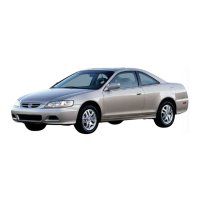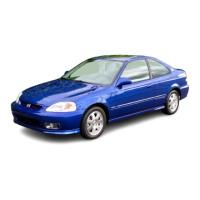
Do you have a question about the Honda 2003 Accord Coupe and is the answer not in the manual?
| Brand | Honda |
|---|---|
| Model | 2003 Accord Coupe |
| Category | Automobile |
| Language | English |
Details on the vehicle's seat belt system, its components, and proper usage for adult occupants.
Information on the Supplemental Restraint System (SRS) including front, side, and curtain airbags.
Guidance on adjusting front seats for proper driving position and safety, especially regarding airbags.
Detailed steps on how to properly fasten and position seat belts for maximum protection.
Emphasizes the legal requirement and safety benefits of restraining all children in vehicles.
Key precautions for parents regarding child seating and seat belt use, including never holding a child on a lap.
Recommends placing children in the back seat due to reduced risk from airbags and interior impacts.
Highlights the severe risks to children from front airbags due to their force and size.
Recommendations for larger children on booster seats and proper seat belt usage, emphasizing back seat safety.
Criteria for selecting a child seat, including safety standards and proper fit.
Specific recommendations for restraining infants in rear-facing seats.
Guidance on using forward-facing child seats for children who have outgrown rear-facing seats.
Details the hazards of placing children in front seats with active airbags.
Specifies that rear-facing child seats should only be placed in the back seat.
Instructions on securing a child seat using the seat belt or LATCH system.
Guidance on testing the child seat for secure installation and proper fit.
Steps to properly buckle the child into the child seat according to manufacturer's instructions.
Recommends forward-facing seats for children over one year old, preferably with a five-point harness.
Recommends placing forward-facing child seats in the back seat to avoid airbag hazards.
Guidance on checking seat belt fit for children, ensuring proper positioning on hips and shoulder.
Instructions for installing LATCH-compatible child seats using lower anchors and tethers.
Explains the dual-stage, dual-threshold operation of front airbags during a collision.
Details the operation of side airbags, which protect the upper torso during side impacts.
Explains the function of side curtain airbags, which protect heads during side impacts.
Explanation of the various indicator lights on the instrument panel and their meanings.
Guidance on adjusting front seats forward/backward and seat-back angle for safety and comfort.
Overview of the heating and cooling system, including control functions and proper usage.
Details on the automatic climate control system, fan speed, and air flow adjustments.
Information on the AM/FM/CD audio system, including radio operation and sound adjustments.
Details on how the security system protects the car from theft, including alarm activation.
Instructions on using cruise control, including setting speed, cancelling, and changing speed.
Information on programming HomeLink to operate garage doors and other home devices.
Key driving recommendations for the first 600 miles to ensure long-term reliability and performance.
Step-by-step instructions for safely filling the fuel tank, including fuel cap handling.
Procedure for checking engine oil level, including dipstick usage and proper fluid level.
Instructions on checking the engine coolant level in the radiator reserve tank.
Tips on driving moderately, maintaining speed, and using cruise control for better fuel economy.
Safety precautions related to airbag covers, objects near doors, and seat covers.
Determining the correct cargo and luggage load limit based on vehicle weight ratings.
Daily checks and adjustments required before driving the vehicle for safety and proper operation.
Procedures for starting the engine under normal, cold weather, and high altitude conditions.
Information on the vehicle's braking system, including wear indicators and ABS operation.
Details on the Traction Control System (TCS), its operation, and indicators.
Techniques and precautions for driving in rain, fog, snow, and other adverse weather conditions.
Guidelines for towing a trailer, including load limits, equipment, and safety practices.
Details on the Anti-lock Brake System (ABS), its function, and how it helps retain steering control.
Techniques for safe driving in rain, fog, and snow, emphasizing smooth control inputs.
Information on load limits, including Gross Vehicle Weight Rating (GVWR) and Gross Axle Weight Rating (GAWR).
Specifies the maximum allowable weight for the vehicle, occupants, cargo, and trailer tongue.
Details the maximum weight allowed on the front and rear axles for various models.
General safety precautions and essential practices for performing vehicle maintenance.
Key safety warnings for maintenance tasks, including potential hazards from exhaust, hot parts, and moving parts.
Specifies service intervals and recommendations for normal and severe driving conditions.
Step-by-step instructions for adding engine oil, including proper fill level and cap installation.
Instructions on adding coolant to the reserve tank and radiator, including proper mixture.
Procedure for checking and adding automatic transmission fluid, including fluid type recommendations.
Instructions for checking and adding fluid for the 5-speed manual transmission.
Instructions for checking and adding fluid for the 6-speed manual transmission.
Guidance on checking brake fluid level and inspecting for leaks or worn brake pads.
Guidance on checking tire pressure, including cold pressure recommendations and gauge usage.
Detailed steps for safely changing a flat tire, including tool usage and safety warnings.
Troubleshooting steps for engine starting issues, based on starter motor sounds.
Procedure for jump starting a car with a booster battery, emphasizing safety precautions.
Steps to take if the engine overheats, including pulling over, turning off accessories, and checking coolant.
Explanation of the low oil pressure indicator light and immediate actions to take.
Information on the charging system indicator light and actions to take if it remains on.
Explanation of the malfunction indicator lamp related to emissions control systems.
Explanation of the brake system indicator light, its causes, and recommended actions.
Guidance on professional towing services and proper procedures for towing the vehicle.
Troubleshooting steps for when the starter motor doesn't operate or operates very slowly.
Troubleshooting for when the starter operates normally but the engine won't start.
Steps for checking fuses, identifying blown fuses, and replacing them correctly.
Recommended unleaded gasoline octane rating and information on oxygenated fuels.
Recommended cold tire pressures for front and rear tires for various models.












